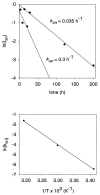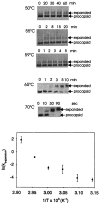Mechanism of capsid maturation in a double-stranded DNA virus
- PMID: 9707570
- PMCID: PMC21431
- DOI: 10.1073/pnas.95.17.9885
Mechanism of capsid maturation in a double-stranded DNA virus
Abstract
Folding mechanisms of proteins incorporated within supramolecular assemblies, including viruses, are little understood and may differ fundamentally from folding mechanisms of small globular proteins. We describe a novel Raman dynamic probe of hydrogen-isotope exchange to investigate directly these protein folding/assembly pathways. The method is applied to subunit folding in assembly intermediates of the double-stranded DNA bacteriophage P22. The icosahedral procapsid-to-capsid maturation (shell expansion) of P22 is shown to be accompanied by a large increase in exchange protection of peptide beta-strands. The molecular mechanism of shell expansion involves unfolding of metastable tertiary structure to form more stable quaternary contacts and is governed by a surprisingly high activation energy. The results demonstrate that coat subunit folding and capsid expansion are strongly coupled processes. Subunit structure in the procapsid represents a late intermediate along the folding/assembly pathway to the mature capsid. Coupling of folding and assembly is proposed as a general pathway for the construction of supramolecular complexes.
Figures






Similar articles
-
Characterization of subunit structural changes accompanying assembly of the bacteriophage P22 procapsid.Biochemistry. 2001 Jan 23;40(3):665-74. doi: 10.1021/bi001965y. Biochemistry. 2001. PMID: 11170383
-
Mechanisms of virus assembly probed by Raman spectroscopy: the icosahedral bacteriophage P22.Biophys Chem. 1997 Oct;68(1-3):17-31. doi: 10.1016/s0301-4622(97)00001-x. Biophys Chem. 1997. PMID: 9468607
-
Cavity defects in the procapsid of bacteriophage P22 and the mechanism of capsid maturation.J Mol Biol. 1999 Apr 2;287(3):527-38. doi: 10.1006/jmbi.1999.2614. J Mol Biol. 1999. PMID: 10092457
-
'Let the phage do the work': using the phage P22 coat protein structures as a framework to understand its folding and assembly mutants.Virology. 2010 Jun 5;401(2):119-30. doi: 10.1016/j.virol.2010.02.017. Epub 2010 Mar 16. Virology. 2010. PMID: 20236676 Free PMC article. Review.
-
Assembly of Structurally Simple Icosahedral Viruses.Subcell Biochem. 2024;105:403-430. doi: 10.1007/978-3-031-65187-8_11. Subcell Biochem. 2024. PMID: 39738953 Review.
Cited by
-
Polyhead formation in phage P22 pinpoints a region in coat protein required for conformational switching.Mol Microbiol. 2007 Sep;65(5):1300-10. doi: 10.1111/j.1365-2958.2007.05868.x. Epub 2007 Aug 3. Mol Microbiol. 2007. PMID: 17680786 Free PMC article.
-
Use of the interior cavity of the P22 capsid for site-specific initiation of atom-transfer radical polymerization with high-density cargo loading.Nat Chem. 2012 Oct;4(10):781-8. doi: 10.1038/nchem.1442. Epub 2012 Aug 26. Nat Chem. 2012. PMID: 23000990 Free PMC article.
-
Structure and dynamics of the DNA-binding protein HU of B. stearothermophilus investigated by Raman and ultraviolet-resonance Raman spectroscopy.Protein Sci. 2003 Apr;12(4):861-70. doi: 10.1110/ps.0234103. Protein Sci. 2003. PMID: 12649443 Free PMC article.
-
Virus particle maturation: insights into elegantly programmed nanomachines.Curr Opin Struct Biol. 2010 Apr;20(2):210-6. doi: 10.1016/j.sbi.2010.01.004. Epub 2010 Feb 9. Curr Opin Struct Biol. 2010. PMID: 20149636 Free PMC article. Review.
-
Enhancing Multistep Reactions: Biomimetic Design of Substrate Channeling Using P22 Virus-Like Particles.Adv Sci (Weinh). 2023 May;10(13):e2206906. doi: 10.1002/advs.202206906. Epub 2023 Feb 23. Adv Sci (Weinh). 2023. PMID: 36815387 Free PMC article.
References
Publication types
MeSH terms
Substances
Grants and funding
LinkOut - more resources
Full Text Sources

